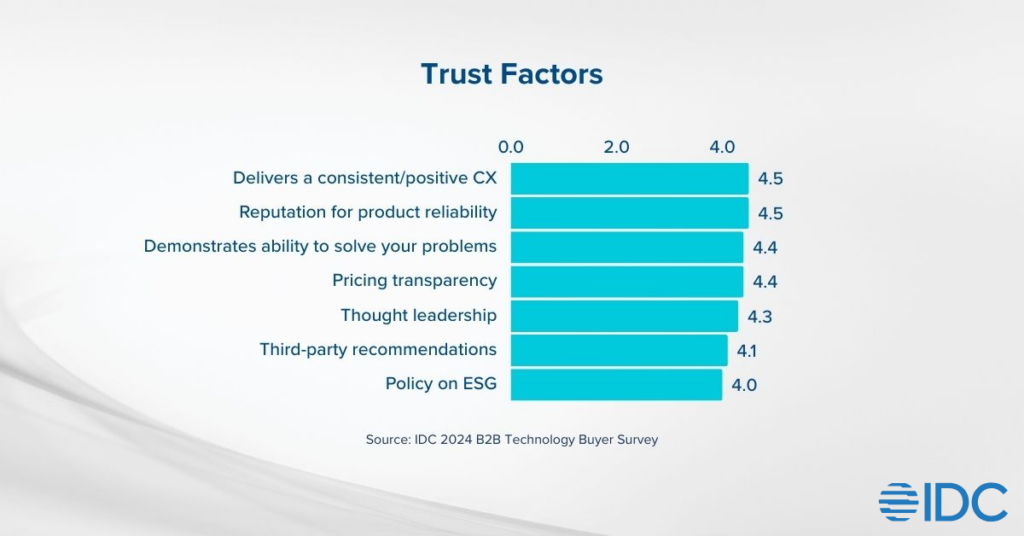As a growing tech vendor, gaining traction in a competitive marketplace can be a daunting challenge. While creating in-house content is crucial for brand visibility, there’s another powerful tool that can significantly enhance your credibility and market positioning: third-party content. Independent, expert-driven insights like analyst briefs, whitepapers, and industry reports offer an unbiased, authoritative perspective that customers trust, helping you stand out from the competition.
In this blog, we’ll explore three reasons why third-party content matters for growing tech vendors and provide actionable tips on how best to use it to drive growth.
1. Builds Trust and Credibility
One of the biggest hurdles for emerging tech vendors is building trust with customers and investors. No matter how strong your product or service is, buyers are often skeptical of vendor-authored content because they understand it ultimately serves your interests. This is where third-party content, such as analyst briefs or independent whitepapers, becomes invaluable.
Independent analysts and research firms like IDC have earned reputations for providing impartial, data-backed insights. By leveraging content from these sources, you align your brand with trusted voices, lending credibility to your solutions and establishing a stronger position in the market. Customers are more likely to trust your offering when it’s supported by an unbiased, expert perspective.
How to Use It:
- Reference third-party reports and data points in your blog posts, case studies, and sales presentations to add weight to your claims.
- Use analyst-backed insights to create a more compelling narrative in your marketing campaigns, positioning your product within the broader market context.
- Promote whitepapers or reports on your website as gated content to attract leads, showcasing your company’s alignment with industry trends.
Example:
When launching a new product, reference findings from a relevant IDC report that validates your solution’s importance within your niche. Incorporating trusted data helps position your offering as a solution to real market needs, easing the buyer’s decision-making process.

2. Enhances Your Go-to-Market Strategy
In a fast-paced tech landscape, staying ahead of emerging trends is essential for creating a strong go-to-market strategy. Third-party content provides valuable insights into market dynamics, competitive landscapes, and customer behavior, helping you make informed decisions. Analyst reports and industry studies can reveal growth opportunities, identify potential challenges, and offer strategic recommendations that align with where the market is heading.
By leveraging these insights, you can fine-tune your go-to-market approach, ensuring your product or service is positioned to meet current and future demand. Whether you’re entering a new market, launching a new feature, or refining your sales approach, third-party content gives you the context and data needed to make informed, strategic moves.
How to Use It:
- Integrate analyst predictions into your product development roadmap, ensuring your offerings are aligned with future market trends.
- Use insights from industry reports to identify growth opportunities or untapped customer segments.
- Incorporate findings into pitch decks or investor presentations, highlighting how your company is staying ahead of the curve.
Example:
A growing SaaS company can leverage IDC market reports to refine its product roadmap, ensuring that features being developed align with customer needs and anticipated market shifts. By using these reports to guide product development, the company stays competitive and relevant as customer demands evolve.
3. Differentiates You from Competitors
In crowded tech markets, differentiation is key to standing out. While every vendor can create content promoting their product, third-party content provides an extra layer of differentiation. It offers an independent, trusted perspective that helps validate your position and sets you apart from competitors who may only rely on self-promotion. By backing your claims with third-party reports and analysis, you strengthen your value proposition and present a more balanced, credible view of your solution.
Moreover, independent content can highlight your unique strengths or competitive advantages in a way that resonates with buyers. For instance, an analyst report that highlights emerging trends can help position your product as a cutting-edge solution, differentiating you from competitors who aren’t addressing the same needs.
How to Use It:
- Use third-party comparisons or reviews from analyst firms to demonstrate how your solution outperforms competitors.
- Reference independent content in product launches or feature announcements to highlight why your offering stands out in the marketplace.
- Share third-party reports that showcase your company’s alignment with market trends, positioning yourself as an industry leader.
Example:
When launching a product update, include a relevant IDC report that shows why your solution addresses the latest market trends. Use this to highlight your forward-thinking approach and differentiate your product from competitors who aren’t keeping pace with these changes.
How to Maximize the Value of Third-Party Content
To get the most out of third-party content, it’s important to use it strategically across multiple channels. Here are some best practices to ensure you’re maximizing its impact:
- Repurpose Content Across Platforms: Turn a single analyst report into multiple pieces of content, such as blog posts, infographics, and social media snippets. Repurposing allows you to reach different audience segments while making the most of your content investment.
- Use It in Lead Generation Campaigns: Third-party content is often seen as more trustworthy, making it highly effective for lead generation. Offer whitepapers or reports as gated content, attracting high-quality leads who are seeking unbiased, expert insights.
- Incorporate It into Sales Conversations: Equip your sales team with third-party reports and whitepapers to help them build trust with potential clients. These materials can strengthen your sales pitch by providing a neutral perspective that validates your solution.
- Cite It in Thought Leadership: Align your brand with independent, trusted voices by referencing third-party content in webinars, blog posts, and thought leadership articles. This not only enhances your credibility but also helps position your company as an informed industry player.
Conclusion
For early-stage to mid-market tech vendors, building credibility and driving growth relies on increasing market awareness, generating leads, and capturing investor attention. Third-party content, such as analyst reports and whitepapers, is a powerful tool to help you achieve these goals. By partnering with a respected analyst firm, you gain independent validation that enhances your brand’s visibility and builds trust across the tech ecosystem.
Leveraging third-party insights helps you understand your competitive landscape, target key audiences, and refine your go-to-market strategies. Whether you’re focused on product differentiation, customer engagement, or growth acceleration, independent content provides the expertise and authority to back your claims.
For over 60 years, IDC has helped startups and growing tech vendors navigate the complexities of the market, building third-party validation that drives recognition and growth. Ready to take the next step?
Contact us today to learn how IDC can help you build momentum and accelerate your success.




